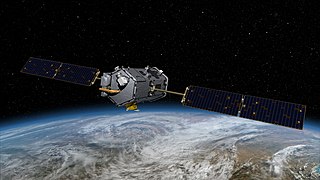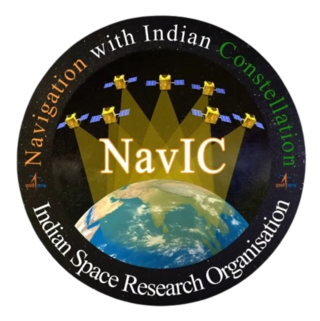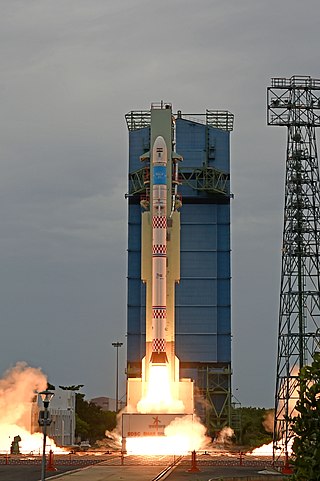
The Polar Satellite Launch Vehicle (PSLV) is an expendable medium-lift launch vehicle designed and operated by the Indian Space Research Organisation (ISRO). It was developed to allow India to launch its Indian Remote Sensing (IRS) satellites into Sun-synchronous orbits, a service that was, until the advent of the PSLV in 1993, only commercially available from Russia. PSLV can also launch small size satellites into Geostationary Transfer Orbit (GTO).

Pegasus is an air-launched launch vehicle developed by Orbital Sciences Corporation (OSC) and now built and launched by Northrop Grumman. Pegasus is the world's first privately developed orbital launch vehicle. Capable of carrying small payloads of up to 443 kg (977 lb) into low Earth orbit, Pegasus first flew in 1990 and remains active as of 2021. The vehicle consists of three solid propellant stages and an optional monopropellant fourth stage. Pegasus is released from its carrier aircraft at approximately 12,000 m (39,000 ft), and its first stage has a wing and a tail to provide lift and altitude control while in the atmosphere. Notably, the first stage does not have a thrust vector control (TVC) system.

Minotaur-C, formerly known as Taurus or Taurus XL, is a four stage solid fueled launch vehicle built in the United States by Orbital Sciences and launched from SLC-576E at California's Vandenberg Air Force Base. It is based on the air-launched Pegasus rocket from the same manufacturer, utilizing a "zeroth stage" in place of an airplane. The Minotaur-C is able to carry a maximum payload of around 1458 kg into a low Earth orbit (LEO).

The Orbiting Carbon Observatory (OCO) is a NASA satellite mission intended to provide global space-based observations of atmospheric carbon dioxide. The original spacecraft was lost in a launch failure on 24 February 2009, when the payload fairing of the Taurus rocket which was carrying it failed to separate during ascent. The added mass of the fairing prevented the satellite from reaching orbit. It subsequently re-entered the atmosphere and crashed into the Indian Ocean near Antarctica. The replacement satellite, Orbiting Carbon Observatory-2, was launched 2 July 2014 aboard a Delta II rocket. The Orbiting Carbon Observatory-3, a stand-alone payload built from the spare OCO-2 flight instrument, was installed on the International Space Station's Kibō Exposed Facility in May 2019.

The Launch Vehicle Mark-3 or LVM3 is a three-stage medium-lift launch vehicle developed by the Indian Space Research Organisation (ISRO). Primarily designed to launch communication satellites into geostationary orbit, it is also due to launch crewed missions under the Indian Human Spaceflight Programme. LVM3 has a higher payload capacity than its predecessor, GSLV.

The Indian Regional Navigation Satellite System (IRNSS), with an operational name of NavIC, is an autonomous regional satellite navigation system that provides accurate real-time positioning and timing services. It covers India and a region extending 1,500 km (930 mi) around it, with plans for further extension up to 3,000 km (1,900 mi). An extended service area lies between the primary service area and a rectangle area enclosed by the 30th parallel south to the 50th parallel north and the 30th meridian east to the 130th meridian east, 1,500–6,000 km (930–3,730 mi) beyond borders where some of the NavIC satellites are visible but the position is not always computable with assured accuracy. The system currently consists of a constellation of eight satellites, with two additional satellites on ground as stand-by.

The Glory satellite was a planned NASA satellite mission that would have collected data on the chemical, micro-physical and optical properties—and the spatial and temporal distributions—of sulfate and other aerosols, and would have collected solar irradiance data for the long-term climate record. The science focus areas served by Glory included: atmospheric composition; carbon cycle, ecosystems, and biogeochemistry; climate variability and change; and water and energy cycles. The US$424 million satellite was lost on 4 March 2011, when its Taurus XL carrier rocket malfunctioned. A subsequent investigation revealed that the fairing system failed to open fully, causing the satellite to reenter the atmosphere at which point it likely broke up and burned. NASA investigators later determined the cause for the launch failure to be faulty materials provided by aluminum manufacturer Sapa Profiles.

This comparison of orbital launch systems lists the attributes of all individual rocket configurations designed to reach orbit. A first list contains rockets that are operational or in development as of 2023; a second list includes all upcoming rockets and a third list includes all retired rockets. For the simple list of all conventional launcher families, see: Comparison of orbital launchers families. For the list of predominantly solid-fueled orbital launch systems, see: Comparison of solid-fueled orbital launch systems.
KySat-1 was an American satellite which was to have been operated by Kentucky Space. Designed to operate for eighteen to twenty four months, it was lost in a launch failure in March 2011 after the Taurus launch vehicle carrying it failed to achieve orbit.
Hermes was an American satellite which was to have been operated by the Colorado Space Grant Consortium. Intended to perform technology demonstration experiments in low Earth orbit, it was lost during launch in March 2011 when the rocket that was carrying it failed to achieve orbit.

This article compares different orbital launcher families. The article is organized into two tables: the first contains a list of currently active and under-development launcher families, while the second contains a list of retired launcher families.
IRNSS-1A is the first navigational satellite in the Indian Regional Navigation Satellite System (IRNSS) series of satellites been placed in geosynchronous orbit.
IRNSS-1E is the fifth out of seven in the Indian Regional Navigational Satellite System (IRNSS) series of satellites after IRNSS-1A, IRNSS-1B, IRNSS-1C and IRNSS-1D. It is one among the seven of the IRNSS constellation of satellites launched to provide navigational services to the region. The satellite was placed in geosynchronous orbit. IRNSS-1E has been successfully launched into orbit on 20 January 2016

IRNSS-1F is the sixth navigation satellite out of seven in the Indian Regional Navigational Satellite System (IRNSS) series of satellites after IRNSS-1A, IRNSS-1B, IRNSS-1C, IRNSS-1D and IRNSS-1E. The satellite is one among the seven of the IRNSS constellation of satellites launched to provide navigational services to the region.

IRNSS-1H was the eighth in the Indian Regional Navigational Satellite System (IRNSS) series of satellites, after IRNSS-1A, IRNSS-1B, IRNSS-1C, IRNSS-1D, IRNSS-1E, IRNSS-1F and IRNSS-1G. It was lost in the launch failure of PSLV-C39 on August 31, 2017.
Polar Satellite Launch Vehicle – C39 was the forty-first flight of the PSLV series of launch vehicles on 31 August 2017. Launched in its XL configuration, the vehicle suffered a rare failure – the first failure after 24 years of operations when the heat shield failed to separate and the payload became trapped inside the heat shield and could not be deployed.

The Small Satellite Launch Vehicle (SSLV) is a small-lift launch vehicle developed by ISRO with payload capacity to deliver 500 kg (1,100 lb) to low Earth orbit or 300 kg (660 lb) to Sun-synchronous orbit for launching small satellites, with the capability to support multiple orbital drop-offs. SSLV is made keeping low cost, low turnaround time in mind with launch-on-demand flexibility under minimal infrastructure requirements.

PSLV-C41 was the 43rd mission of the Indian Polar Satellite Launch Vehicle (PSLV) rocket. It was launched on Thursday, April 12, 2018, at 04:04 Hrs (IST) by the Indian Space Research Organisation (ISRO) from the first launch pad of the Satish Dhawan Space Centre at Sriharikota, Andhra Pradesh. This was the 12th mission to use the PSLV XL configuration.

















